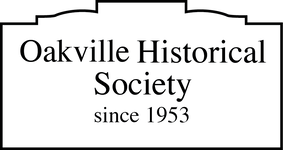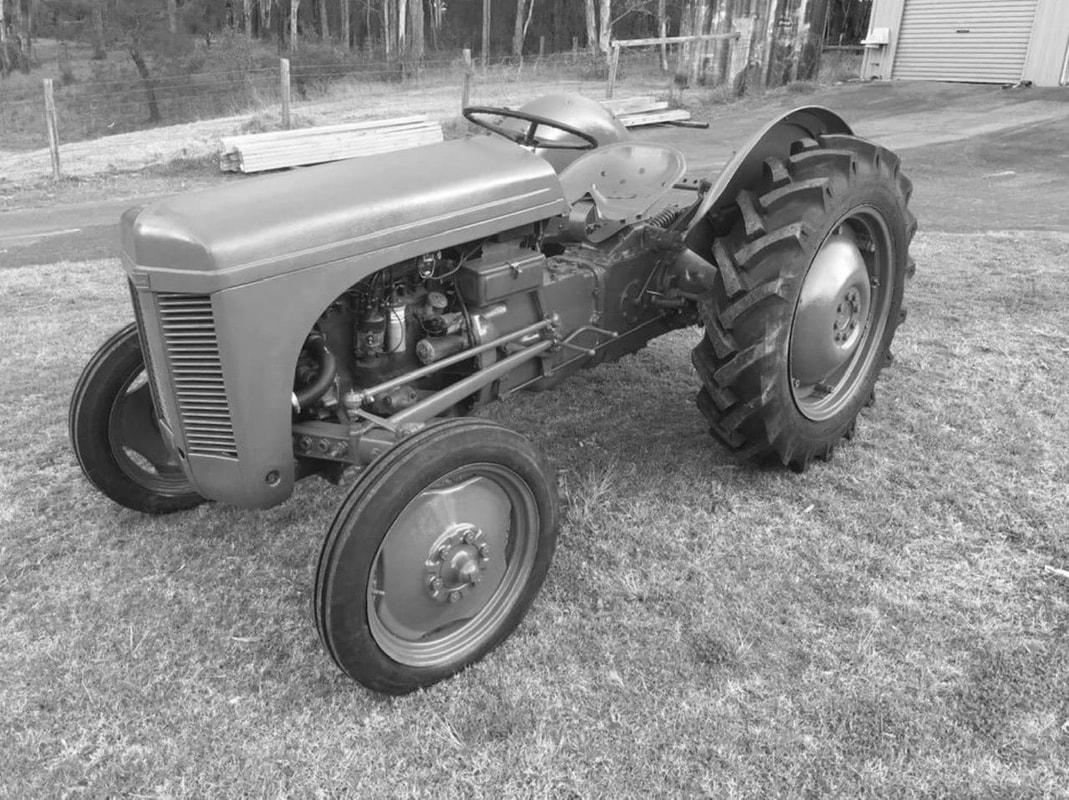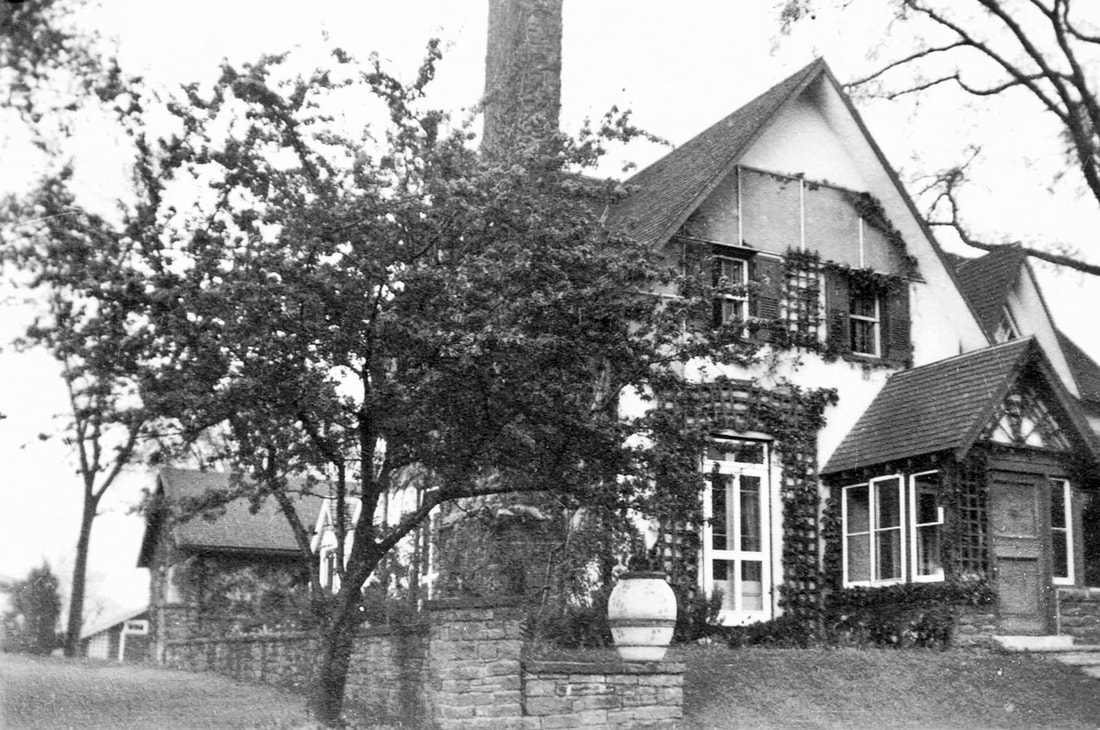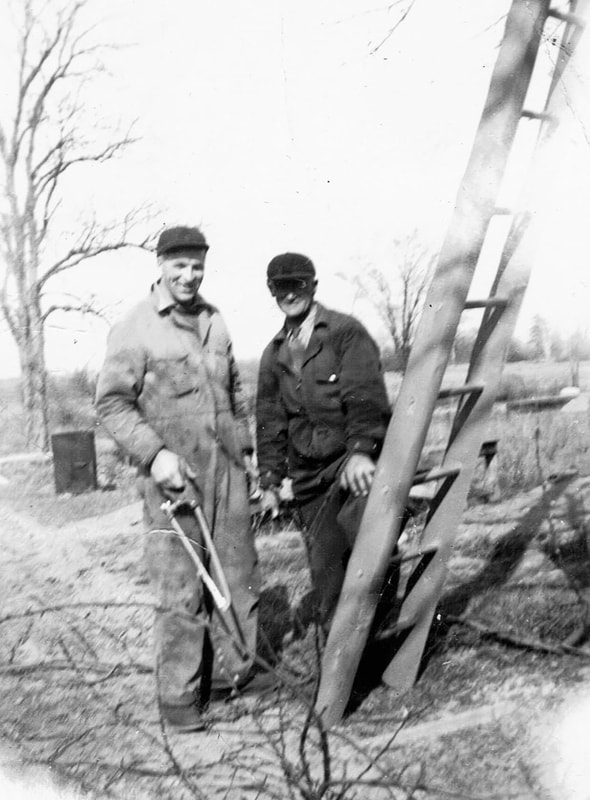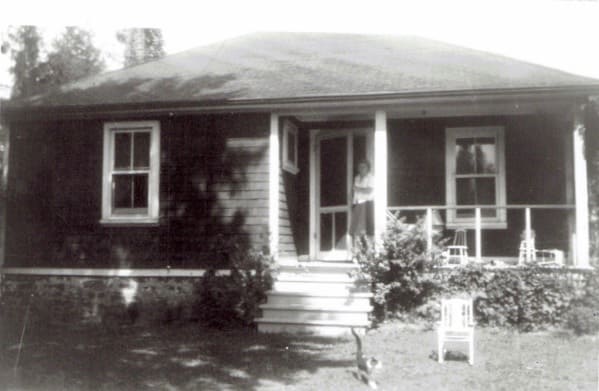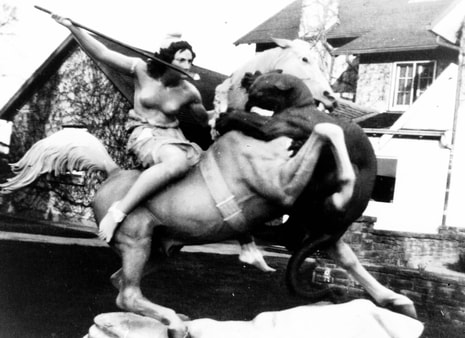|
“Away you go, Patsy”, said Doug Wilson to his 5
year-old daughter, as he reached over to push down the clutch of the tractor with his hand because she was too short to do it herself. Patricia (Patsy) slowly drove the full-sized tractor down the rows of the orchard. As she rolled past the men and women picking, they would hoist their bushels of apples into the trailer behind her tractor. A cherubic little girl, she would drive the tractor a few hours a day during apple picking season. She didn’t mind. She loved being her daddy’s right-hand girl. Sometimes her threeyear- old sister, Carrol, would ride in the trailer. Two tiny girls bouncing along on a tractor and a trailer while the grown-ups were busy picking apples! Once Carrol stuck her leg out and got a bad brush burn from the tire. There is a stretch of road on Fourth Line, north of
Rebecca, that still has houses widely-spaced apart. At 425 Fourth Line, there was a sign that |
read ‘Wilton Farm’. The enormous farm house
was built around 1859 by James W. McCraney and his wife Augusta. In 1944, the farm was owned by Calvin S. Parker. He was the owner of several companies and held the patent for the original ditch-digging steam engine. Patricia remembers him commuting to Toronto in a big white car, always smoking a cigar. He hired Patricia’s father to be the farm manager. Doug Wilson used to work in Toronto. He tried to enlist for the war, but wasn’t accepted. He met Patricia’s mother, Dorothy Bellerby, on ‘Firecracker Day’ (Victoria Day), May 24th 1940. At the time, she was a cook at Appleby College and they married the next year, on August 16th 1941. Then the army called again. However, Doug refused to enlist now, since he had a wife to support. Because he was a farmer’s son, the army required that he work on a farm in lieu of becoming a soldier. He and Dorothy worked on several farms together and eventually they came to work for CS Parker, where Doug was the |
|
manager. His many responsibilities included supervising other staff and maintaining the generator, which was in a cabin on the edge of the ravine. The Parkers lived in the big house on the front of the property. The Wilsons lived farther up the road in a smaller house.
There were apple trees, cherry trees and pear trees and there were raspberries in the ravine behind the house. Patricia’s mother would run out and pick cherries to make pies. Then the cherries had to be pitted and the dough made. It took a whole morning to make pies for supper. Other employees on the farm included a gardener and three farm labourers. The farm labourers were new immigrants known as DPs, Displaced Persons. They lived as boarders in a wing at the back of the Wilsons’ house. Patricia remembers a man from England, and a Dutch man who had wooden shoes. For a while, a Polish man also boarded with them, and his language was fascinatingly colourful. One afternoon, while her father was chatting with Mr. Parker, little Patsy began throwing stones onto the flagstones at the back of the house. Mr. Parker took his cigar out of his mouth and told her to stop. She yelled ‘Taka hui!’, threw one hand up in the air, and slapped her elbow with the other hand, just like she had seen the Polish farmhand do. She had no idea what it meant, but she suspected it was rude, and ran away. When Mr. Parker asked what she had said, her father feigned ignorance. When it was time to go to kindergarten, Patricia and the boy living across the street, with the unlikely name of Freddy Snowball, would walk by themselves on the side of Fourth Line, a dirt road, to Rebecca St. and catch the Greyhound bus. The school bus didn’t run at noon for the half-day kindergarten class, so the youngest students of the school took the inter-city bus! |
|
Patricia’s roots go deep in Oakville. Her greatgrandparents came to Canada in 1884. When
her great-grandmother Martha died, greatgrandfather John sailed on a ship back to England to fetch another wife, Evelyn Ward. They lived on Gilbrea farm, in the area that eventually became Bronte. The first church services of this area were held in his house, and often one of the men in the family acted as pastor. John Wilson donated land and helped to build the small white church that was the original Church of the Epiphany, which is still on Bronte Road. Little curly-haired Patsy cut the ribbon for the church hall. The cross made of two beams from his barn is still in the church today. Patricia’s grandfather, Alexander Wilson, was born in Bronte in 1888. He served in the First World War and when he came home he married Ethel Young in 1920. They farmed one hundred acres at the corner of Rebecca and Third Line and called their farm Bellehome. When she was not driving the tractor or sitting next to her father on the bulldozer, Patsy and her sister played on the deer statues adorning the front lawn beside the ‘Lady Guinevere’ statue, a bare-chested Amazonian with a spear, being attacked by a dragon. Every now and again an artist came to spray the statues with fresh paint: bright colours for Lady Guinevere and the dragon, natural colours for the deer. One year he spray-painted a large wall painting for them to hang in the house. Once a week, Patsy and Carrol would walk through the orchard and go to the Big House for lunch in the kitchen with Clara Baker, the young woman who was the Parker ’s cook and housekeeper. The little girls always wore pretty dresses for this special event. There were red and white cushions on the chairs, an enormous fridge with two doors set into the wall, a step down into a sunroom at the side of the house, a big chandelier with fancy fringes over the dining room table. Clara had her quarters, a bedsitting room, off the kitchen. Sometimes someone important would unexpectedly arrive before she had tidied away lunch! Clara would quickly load the dishes into a big pan and hide them under her bed. Sometimes the girls would go upstairs to visit Ethel, CS Parker’s wife, who was very ill. |
|
Clara had met CS Parker in Newfoundland when he was there on business, and he offered her the housekeeping job. She worked for him for decades, even after his wife Ethel died in 1952 and he married a second time, to a woman named Jeannie. When Patricia visited the farm in 1969, Clara was still there, but she later moved back to Newfoundland.
Patricia’s family lived at the Parker’s until July 1951. She eventually went to college intending to become a Home Economics teacher, but she married a dairy farmer and came back to farming. She and her husband now live north of Cornwall Ontario, getting up daily at 5:30 a.m. to feed 55 cows, while her son and daughter-in-law do the milking. The dairy farm has been her home since 1967. After CS Parker’s death in 1969, the statues on the front lawn were auctioned off. The orchard was cut down and became a neighbourhood of modern houses. |
You can still see the Parker farmhouse standing in its original immense glory at 425 Fourth Line. The east of of Fourth, north of Rebecca. |
